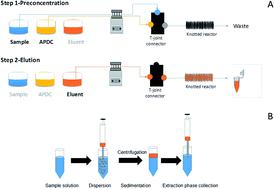当前位置:
X-MOL 学术
›
J. Anal. At. Spectrom.
›
论文详情
Our official English website, www.x-mol.net, welcomes your feedback! (Note: you will need to create a separate account there.)
Development of preconcentration strategies for the simultaneous ultratrace determination of As, Cd and Pb in foods by ICP-OES: knotted-reactor vs. dispersive liquid–liquid microextraction
Journal of Analytical Atomic Spectrometry ( IF 3.4 ) Pub Date : 2020-03-11 , DOI: 10.1039/c9ja00427k David Martínez-Rubio 1, 2, 3, 4 , Guillermo Grindlay 1, 2, 3, 4 , Mauricio Llaver 5, 6, 7, 8, 9 , Rodolfo G. Wuilloud 5, 6, 7, 8, 9 , Juan Mora 1, 2, 3, 4
Journal of Analytical Atomic Spectrometry ( IF 3.4 ) Pub Date : 2020-03-11 , DOI: 10.1039/c9ja00427k David Martínez-Rubio 1, 2, 3, 4 , Guillermo Grindlay 1, 2, 3, 4 , Mauricio Llaver 5, 6, 7, 8, 9 , Rodolfo G. Wuilloud 5, 6, 7, 8, 9 , Juan Mora 1, 2, 3, 4
Affiliation

|
Determination of As, Cd and Pb in food samples by means of inductively coupled plasma optical emission spectrometry (ICP-OES) is challenging due to detection limits being close to the maximum levels established by current international food security policies. This work evaluates the benefits and drawbacks of knotted reactor extraction (KR) and dispersive liquid–liquid microextraction (DLLME) for the simultaneous ultratrace determination of the above-mentioned elements by ICP-OES. To this end, ICP-OES experimental conditions were optimized to minimize the negative effects of organics on plasma characteristics. Next, both KR and DLLME were optimized using the experimental design for the simultaneous As, Cd and Pb preconcentration. KR- and DLLME-ICP-OES methods were compared and applied to the analysis of different food samples, representative of the commodities regulated by the EU policy. Results in this work show that both KR and DLLME allow successful toxic element analysis in foods according to current EU policies. Nevertheless, DLLME is a more attractive approach than KR. First, DLLME allows the simultaneous determination of As, Cd and Pb, while KR is just limited to the last two elements, since As-complexes are not efficiently retained within the system. When compared to conventional ICP-OES analysis (i.e., no preconcentration), DLLME improves limits of detection (LOD) on average by 40-fold for As, Cd and Pb, whereas KR improves it by just 10-fold. For both methodologies, LOD improvement is derived from the preconcentration procedure as well as the beneficial effect of organics on aerosol generation and transport to the plasma compared to aqueous samples. Finally, DLLME affords higher sample throughput and consumption index than KR.
中文翻译:

ICP-OES用于食品中砷,镉和铅的超痕量测定的浓缩方法的开发:打结反应器与分散液-液微萃取
由于检测极限接近当前国际食品安全政策确定的最高水平,因此通过电感耦合等离子体发射光谱法(ICP-OES)测定食品样品中的As,Cd和Pb极具挑战性。这项工作评估了打结反应器萃取(KR)和分散液-液微萃取(DLLME)在同时通过ICP-OES超痕量测定上述元素时的利弊。为此,对ICP-OES实验条件进行了优化,以最大程度地减少有机物对血浆特性的负面影响。接下来,使用同时进行砷,镉和铅预富集的实验设计对KR和DLLME进行了优化。比较了KR-和DLLME-ICP-OES方法,并将其应用于不同食品样品的分析,欧盟政策管制商品的代表。这项工作的结果表明,根据欧盟现行政策,KR和DLLME均可成功地分析食品中的有毒元素。但是,DLLME比KR更有吸引力。首先,DLLME允许同时测定As,Cd和Pb,而KR仅限于最后两个元素,因为As络合物无法有效保留在系统中。与常规ICP-OES分析相比(因为复合物不能有效地保留在系统中。与常规ICP-OES分析相比(因为复合物不能有效地保留在系统中。与常规ICP-OES分析相比(即,无预浓缩),DLLME提高了检测(LOD)平均通过限制40倍对As,Cd和Pb,而KR通过仅10倍改善它。对于这两种方法,LOD的改善都源于预浓缩程序以及与水性样品相比有机物对气溶胶生成和向血浆运输的有益作用。最后,DLLME比KR提供更高的样品通量和消耗指数。
更新日期:2020-03-11
中文翻译:

ICP-OES用于食品中砷,镉和铅的超痕量测定的浓缩方法的开发:打结反应器与分散液-液微萃取
由于检测极限接近当前国际食品安全政策确定的最高水平,因此通过电感耦合等离子体发射光谱法(ICP-OES)测定食品样品中的As,Cd和Pb极具挑战性。这项工作评估了打结反应器萃取(KR)和分散液-液微萃取(DLLME)在同时通过ICP-OES超痕量测定上述元素时的利弊。为此,对ICP-OES实验条件进行了优化,以最大程度地减少有机物对血浆特性的负面影响。接下来,使用同时进行砷,镉和铅预富集的实验设计对KR和DLLME进行了优化。比较了KR-和DLLME-ICP-OES方法,并将其应用于不同食品样品的分析,欧盟政策管制商品的代表。这项工作的结果表明,根据欧盟现行政策,KR和DLLME均可成功地分析食品中的有毒元素。但是,DLLME比KR更有吸引力。首先,DLLME允许同时测定As,Cd和Pb,而KR仅限于最后两个元素,因为As络合物无法有效保留在系统中。与常规ICP-OES分析相比(因为复合物不能有效地保留在系统中。与常规ICP-OES分析相比(因为复合物不能有效地保留在系统中。与常规ICP-OES分析相比(即,无预浓缩),DLLME提高了检测(LOD)平均通过限制40倍对As,Cd和Pb,而KR通过仅10倍改善它。对于这两种方法,LOD的改善都源于预浓缩程序以及与水性样品相比有机物对气溶胶生成和向血浆运输的有益作用。最后,DLLME比KR提供更高的样品通量和消耗指数。



























 京公网安备 11010802027423号
京公网安备 11010802027423号